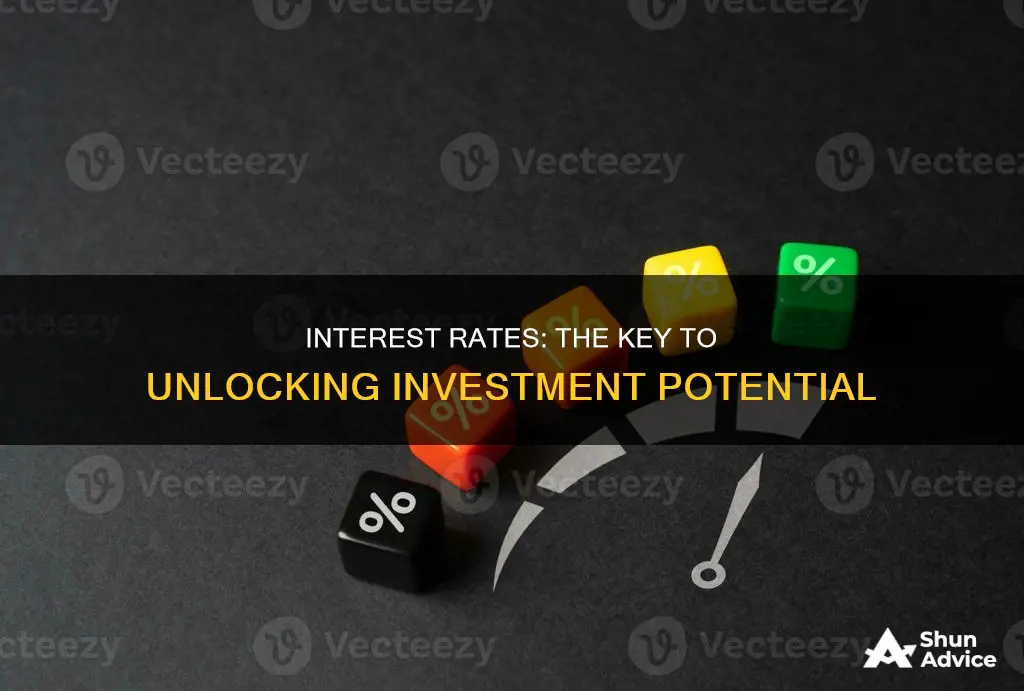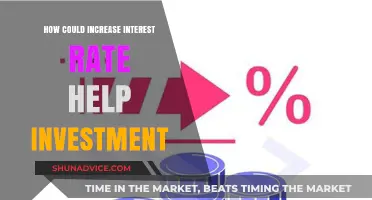
Interest rates play a pivotal role in shaping investment decisions and strategies. When central banks adjust interest rates, it creates a ripple effect across various financial markets and investment vehicles. For investors, understanding how interest rates influence their investment choices is crucial. Rising interest rates often lead to higher borrowing costs, which can impact the profitability of certain investments, especially those with fixed returns. Conversely, lower interest rates may encourage riskier investments as the potential for higher returns becomes more attractive. This dynamic relationship between interest rates and investments is a key consideration for investors, as it can significantly affect their financial outcomes.
What You'll Learn
- Interest Rates and Bond Prices: Higher rates decrease bond prices, impacting investment returns
- Equity Market Sensitivity: Interest rate changes affect stock prices, especially in sensitive sectors
- Impact on Real Estate: Rates influence property values and rental yields, impacting investment strategies
- Currency Fluctuations: Interest rate differentials drive currency movements, affecting international investments
- Inflation and Investment Returns: Higher rates combat inflation, impacting the real value of investment returns

Interest Rates and Bond Prices: Higher rates decrease bond prices, impacting investment returns
Interest rates and bond prices have an inverse relationship, which is a fundamental concept in the bond market. When interest rates rise, bond prices typically fall, and vice versa. This dynamic is crucial for investors to understand, especially those with investments in bonds or considering bond purchases. The reason behind this phenomenon lies in the nature of bond investments and how they are valued.
Bonds are essentially loans made by investors to governments or corporations. When an investor buys a bond, they are essentially lending money to the issuer in exchange for the promise of regular interest payments and the return of the principal amount at maturity. The interest rate on these bonds is a critical factor in determining their price. When market interest rates rise, new bonds issued will offer higher yields to attract investors. As a result, existing bonds with lower interest rates become less attractive, causing their prices to decrease. This is because investors are now willing to pay less for bonds that offer lower returns compared to the newly available, more lucrative options.
For instance, if an investor purchases a bond with a 3% interest rate when the market interest rate is 2%, they are paying a premium for the lower return. If the market interest rate then rises to 4%, the same investor would be better off buying new bonds with the higher yield. Consequently, the price of the older bond would likely drop to reflect its reduced attractiveness. This inverse relationship between interest rates and bond prices is a key consideration for investors, as it directly impacts their investment returns.
Understanding this relationship is essential for investors to make informed decisions. Rising interest rates can lead to decreased bond prices, which may result in lower investment returns. Conversely, when interest rates fall, bond prices tend to increase, potentially providing investors with higher returns. Therefore, investors should monitor interest rate trends and adjust their bond portfolios accordingly to optimize their investment strategies.
In summary, higher interest rates lead to lower bond prices, which can significantly impact investment returns. This relationship is a critical aspect of bond investing and should be carefully considered by investors to ensure their portfolios are aligned with their financial goals and market conditions. Staying informed about interest rate changes is a vital step in making prudent investment choices.
Compound Interest: The Key to Unlocking Long-Term Investment Success
You may want to see also

Equity Market Sensitivity: Interest rate changes affect stock prices, especially in sensitive sectors
The relationship between interest rates and the equity market is a complex and dynamic one, with interest rate changes having a significant impact on stock prices, particularly in sensitive sectors. When central banks adjust interest rates, it creates a ripple effect throughout the economy, and investors closely monitor these changes to gauge their potential impact on various asset classes, including stocks.
One of the primary ways interest rates influence the equity market is through their effect on the cost of capital. Higher interest rates make borrowing more expensive, which can reduce the attractiveness of investments that require significant capital expenditure. This is especially true for sectors that heavily rely on external financing, such as infrastructure, real estate, and certain manufacturing industries. As a result, these sectors may experience a decline in stock prices when interest rates rise, as investors may perceive them as less attractive compared to other sectors that are less sensitive to interest rate fluctuations.
On the other hand, sectors that benefit from lower borrowing costs tend to thrive during periods of declining interest rates. For instance, the technology and financial sectors often exhibit sensitivity to interest rate changes. Technology companies may see increased demand for their products and services as lower interest rates make borrowing more affordable for consumers and businesses, potentially driving up stock prices in this sector. Similarly, financial institutions, particularly those involved in lending and investment banking, can benefit from lower interest rates, leading to potential stock price appreciation.
The sensitivity of certain sectors to interest rate changes is often related to the nature of their business models and the specific factors that influence their profitability. For example, sectors like utilities and consumer staples, which typically offer stable and consistent returns, may be less affected by interest rate shifts. These sectors often have a strong defensive nature, providing essential goods and services that are relatively insensitive to economic cycles. As a result, investors may seek refuge in these sectors during periods of rising interest rates, causing their stock prices to remain relatively stable or even increase.
Understanding the equity market's sensitivity to interest rate changes is crucial for investors and financial analysts. It allows them to make informed decisions regarding portfolio allocation and risk management. By identifying sectors that are likely to be more affected by interest rate movements, investors can adjust their strategies accordingly. For instance, during periods of rising interest rates, investors might consider reducing exposure to sectors sensitive to higher borrowing costs while increasing holdings in sectors that benefit from lower interest rates. This approach can help optimize investment returns and manage risk effectively.
Interest Rates and Investment: Unraveling the Inverse Relationship
You may want to see also

Impact on Real Estate: Rates influence property values and rental yields, impacting investment strategies
Interest rates play a pivotal role in the real estate market, significantly impacting property values and rental yields, which in turn shape investment strategies. When central banks adjust interest rates, this has a ripple effect on the economy, and the real estate sector is particularly sensitive to these changes. Here's a detailed breakdown of how interest rates influence the real estate landscape:
Property Values: Rising interest rates often lead to a decrease in property values. Higher borrowing costs make mortgages more expensive, reducing the affordability of homes for potential buyers. As a result, sellers might need to adjust their asking prices downward to attract buyers who are now more cautious about taking on substantial debt. Conversely, during periods of low interest rates, buyers are more inclined to take out larger mortgages, potentially driving up property prices. This dynamic can create a feedback loop, where rising rates lead to lower values, and falling rates stimulate demand, pushing prices higher.
Rental Yields: Interest rates also have a direct impact on rental yields, which are crucial for real estate investors. Rental yield is the return on investment an investor receives from renting out a property. When interest rates are low, investors can secure cheaper financing for their purchases, which can then be rented out. This results in higher rental yields, making real estate investments more attractive. Conversely, high-interest rates make borrowing more expensive, reducing the potential for high rental income from new investments. As a result, investors might opt for alternative investments, causing a shift in the real estate market.
Investment Strategies: The influence of interest rates on property values and rental yields significantly shapes investment strategies. During periods of rising interest rates, investors might focus on short-term gains, such as flipping properties, to avoid the impact of higher borrowing costs. They may also seek to diversify their portfolios by investing in other asset classes that are less sensitive to interest rate changes. On the other hand, low-interest rates can encourage long-term investments in rental properties, as investors can benefit from stable rental income over extended periods.
Market Sentiment and Demand: Interest rates can also affect market sentiment and buyer/renter demand. When rates are low, there is often a sense of urgency among buyers and renters, leading to increased market activity. This heightened demand can drive up property prices and rental rates. Conversely, high-interest rates may create a more cautious environment, with buyers and renters becoming more selective, potentially slowing down market activity.
In summary, interest rates are a critical determinant of the real estate market's health and direction. Investors and homeowners alike must closely monitor interest rate fluctuations to make informed decisions about buying, selling, or renting properties. Understanding the relationship between interest rates and real estate can help investors navigate market shifts and optimize their investment strategies accordingly.
Unlocking the Bond: How Investment and Interest Rates Dance Together
You may want to see also

Currency Fluctuations: Interest rate differentials drive currency movements, affecting international investments
The relationship between interest rates and currency fluctuations is a critical aspect of international finance, significantly impacting the dynamics of cross-border investments. When a country's central bank adjusts its interest rates, it triggers a chain reaction in the global financial markets, particularly in the foreign exchange (FX) arena. Interest rate differentials, where rates in one country are higher than in another, become a powerful magnet for capital flows, influencing the value of currencies and, consequently, the profitability of international investments.
In the context of international investments, investors often seek opportunities to maximize returns. When interest rates are higher in one country compared to another, it creates an attractive proposition for investors. Higher interest rates mean more attractive returns on investments, drawing foreign capital into the country with the higher rates. This influx of capital can lead to an appreciation of the local currency as demand increases. For instance, if Country A has a central bank that raises interest rates, it might attract investors seeking higher yields, causing the local currency to strengthen against other currencies.
Conversely, when interest rates are lowered or kept low, it can lead to a different set of currency movements. Lower interest rates may discourage foreign investment, as the potential returns become less appealing. This can result in a depreciation of the currency, making it more expensive for foreign investors to purchase assets in that country. For instance, if Country B reduces its interest rates, it might face an outflow of capital as investors seek better opportunities elsewhere, causing the local currency to weaken.
The impact of interest rate differentials on currency values is a dynamic process and can be influenced by various factors. Market sentiment, economic growth prospects, and geopolitical events also play a role in currency movements. Investors must consider not only the interest rate differential but also the overall economic health and stability of a country when making investment decisions. A comprehensive understanding of these factors is essential for navigating the complexities of international investments and managing currency risks effectively.
In summary, interest rate differentials are a powerful force in the currency markets, shaping the investment landscape for international portfolios. Investors must stay informed about global interest rate trends and their potential impact on currency values to make strategic investment choices. Effective management of currency risks is crucial for successful international investment strategies.
Unveiling the Interest Rate Mystery: Savings vs. Investment Accounts
You may want to see also

Inflation and Investment Returns: Higher rates combat inflation, impacting the real value of investment returns
The relationship between interest rates and investment returns is a critical aspect of financial planning, especially when considering the impact of inflation. When central banks raise interest rates, it has a ripple effect on various financial markets and investment strategies. One of the primary goals of adjusting interest rates is to combat inflation, which directly influences the real value of investment returns.
Inflation, a persistent rise in the general price level of goods and services, erodes the purchasing power of money over time. As inflation increases, the real value of money decreases, meaning that a given amount of money can buy fewer goods and services. This phenomenon is particularly relevant for investment returns, as investors seek to protect their capital and generate returns that outpace the inflation rate.
Higher interest rates play a pivotal role in curbing inflation. When rates rise, borrowing becomes more expensive, which can lead to a slowdown in economic activity. As a result, businesses may reduce their spending and investment, and consumers might become more cautious with their spending habits. This reduction in demand can help stabilize prices, thereby combating inflation. By making borrowing more costly, higher interest rates encourage savings and discourage excessive spending, which are essential tools in the central bank's arsenal to maintain price stability.
In the context of investments, higher interest rates can significantly impact the real value of returns. When rates rise, fixed-income investments such as bonds become more attractive. Bondholders receive a fixed rate of interest, and as rates increase, the income generated from these investments becomes more substantial. This can lead to higher investment returns, especially for those with a portfolio heavily weighted in fixed-income securities. However, it's important to note that higher rates may also make some other investments less appealing, as the potential returns on alternative investments might not keep pace with the rising interest rates.
For investors, understanding the relationship between interest rates and inflation is crucial. During periods of high inflation, investors often seek investments that can provide a real return, outpacing the inflation rate. This might include a mix of fixed-income investments, real estate, or certain types of stocks that offer a hedge against inflation. Diversification becomes essential to manage risk and ensure that investment returns can keep up with or exceed the inflation rate, thus preserving the purchasing power of the invested capital.
In summary, higher interest rates are a powerful tool in the fight against inflation, and this has a direct bearing on investment returns. Investors should be aware of these dynamics to make informed decisions, especially when navigating economic cycles and varying interest rate environments. By understanding the interplay between interest rates, inflation, and investment strategies, individuals can better position their portfolios to meet their financial goals and objectives.
Understanding Investment Interest: What It Is and How It Works
You may want to see also
Frequently asked questions
Interest rates play a significant role in shaping investment strategies. When interest rates are low, borrowing becomes cheaper, encouraging investors to take on more debt to finance investments. This can lead to increased investment activity, especially in the stock market, as companies may find it more affordable to raise capital through debt or equity offerings. However, low-interest rates might also prompt investors to seek higher returns in riskier assets, potentially inflating asset prices. Conversely, during periods of high-interest rates, borrowing becomes more expensive, which may discourage excessive risk-taking and encourage investors to seek safer investments like bonds or fixed-income securities.
Interest rate fluctuations can directly impact the value and performance of existing investments. For instance, when central banks raise interest rates, bond prices often fall because new bonds offer higher yields, making older bonds with lower interest rates less attractive. This effect is particularly relevant for investors holding corporate or government bonds. Additionally, interest rate changes can influence the profitability of businesses, especially those heavily reliant on borrowing, as their borrowing costs rise or fall. This, in turn, may affect the overall market sentiment and investment decisions regarding pending investments.
Interest rate trends provide valuable insights for investors to make informed decisions. Rising interest rates can indicate an improving economy, which may lead to higher corporate profits and, consequently, potential gains in equity markets. In such scenarios, investors might consider rebalancing their portfolios towards growth-oriented assets. Conversely, falling interest rates could suggest an economic slowdown, prompting investors to shift their focus towards more defensive sectors or fixed-income investments. Staying informed about interest rate movements and their potential impact on various asset classes is crucial for investors to adapt their strategies and optimize their portfolios accordingly.







